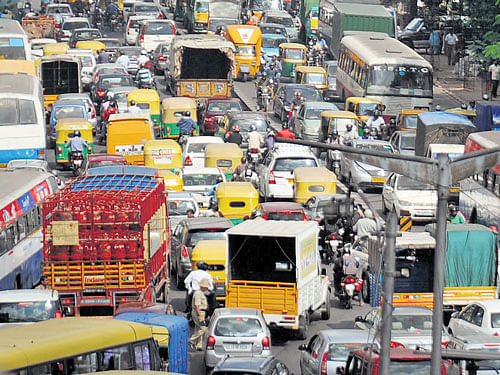
Information on traffic patterns in the City is vital to manage vehicular movement and ensure that there is order on the streets.
Towards this end, the Directorate of Urban Land Transport (DULT), in co-ordination with the traffic police, will set up a one-of-its-kind traffic centre – the Bangalore Traffic Information Centre – which will be the hub of every bit of information about traffic in the City.
The DULT’s proposal has been approved by the State government and is set to get funds from Japan International Co-operation agency (JICA). JICA will send a team to Bengaluru to work out the designs of the traffic centre and on ways to go about building the knowledge hub. The Japan team is set to help in managing the knowledge generated by the study of traffic patterns.
Senior transport officials said the information generated from the study would be shared with various agencies such as the BBMP, BDA, BMRDA, BWSSB, BMTC, KSRTC and others to help them develop the City in a planned manner. An official said: “The information would be vital for other agencies to plan their development activities. We will pass on the information to the different stakeholders of the City. The primary agency which will make use of the information is the Bengaluru Traffic Police though. The agency has the onerous task of maintaining traffic order across the City. The centre would be of good use in the overall management of Bengaluru.”
Bangalore has witnessed a phenomenal growth in vehicle population. As a result, many arterial roads and intersections are operating over the capacity and the average journey speeds on some of the key roads in the central areas are lower than 10 kmph in the peak hour, point out traffic officials.
Interim centre
Meanwhile, an Interim Traffic Management Centre set up at the Ashoknagar police station is doing the job of maintaining order. It has been designed to house a traffic wireless system, traffic surveillance system, traffic signalling system, traffic helpline, traffic planning operations, etc. The centre manages Information/data from the 334 traffic signals spread across the City, live feed of images from over 175 surveillance cameras installed at various junctions and traffic violation data from the five enforcement cameras.
The centre has been linking various elements of Intelligent Transportation Systems such as vehicle-actuated traffic signals, surveillance cameras, enforcement cameras, etc, installed at various locations enabling the decision-makers to identify and react to an incident in a timely manner based on realtime data.
The TMC has also helped reduce incident response times, ensured lower incident rates (mainly secondary incidents), disseminated traveller information and hence reduced congestion and enhanced safety.
The Bangalore Traffic Information Centre will be doing some of these tasks and go beyond these in building a relationship between different City stakeholders.